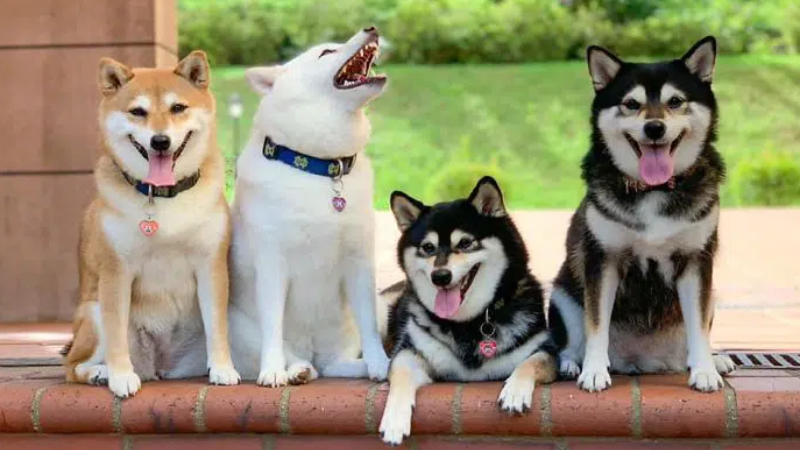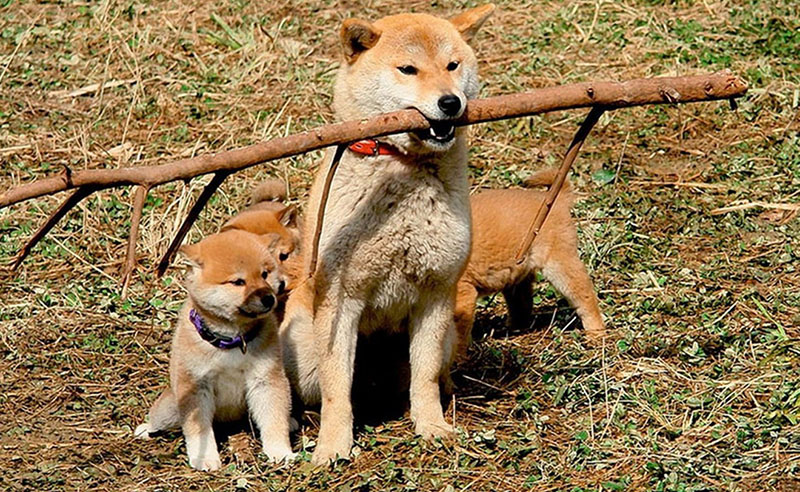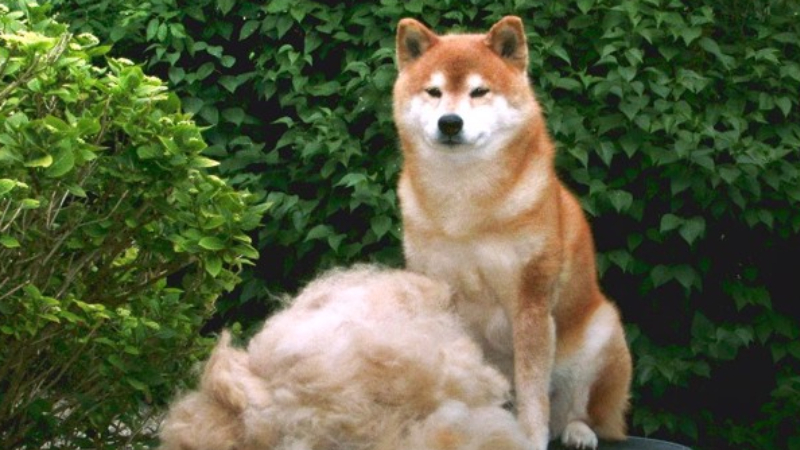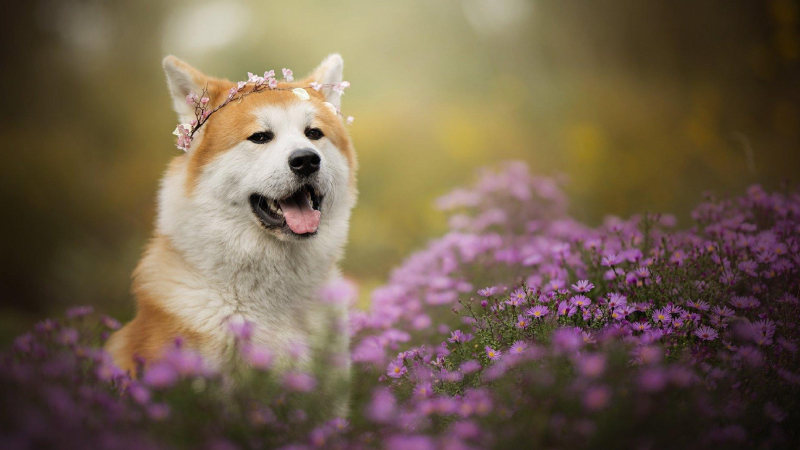If you’re considering getting this breed of dog, take a look at the article below. Here’s some useful information about the Shiba Inu breed that we’ve gathered!
1. All About the Shiba Inu
Origin of the Shiba Inu
 Origin of the Shiba Inu
Origin of the Shiba Inu
The Shiba Inu is the smallest of the six original and distinct spitz breeds of dog from Japan.
Shiba primarily lived in the mountainous regions of Japan. They are an ancient breed that has survived to the present day. The Shiba Inu resembles the Akita Inu but is smaller in size.
Additionally, the Shiba Inu is also known as the “smiling Shiba” due to its upturned mouth, giving it an adorable and cheerful expression.
Common Shiba Inu Coat Colors
The Shiba Inu’s coat comes in a variety of colors. The most common colors include red, black, brown, or sesame. The undercoat can also be various colors such as cream, fawn, gray, or white.
 Common Shiba Inu Coat Colors
Common Shiba Inu Coat Colors
Physical Characteristics of the Shiba Inu
-
Despite their small stature, Shiba Inus are agile and quick. As ancient dogs that lived in the mountains, they have distinct physical traits.
-
Although small, Shiba Inus have well-developed muscles and a sturdy build. They have a small frame and are highly flexible.
Shiba Inus have a double coat:
-
The outer coat is thick, stiff, straight, and glossy.
-
The undercoat is soft and short. The fur on their faces, ears, and legs resembles that of a fox.
The outer guard coat typically measures 4-5 cm in length at the withers (the highest point of the shoulder). Their tails are often fluffy and cute.
 Physical Characteristics of the Shiba Inu
Physical Characteristics of the Shiba Inu
Temperament
-
Shiba Inus have a strong sense of independence and can be aggressive towards other animals. They may not be the best fit for families with multiple dogs or young children due to their aggressive tendencies.
-
While they may seem somewhat rude or standoffish, Shiba Inus are incredibly loyal and affectionate towards their owners. These Japanese dogs always show respect to their owners and are obedient.
-
Shiba Inus are fastidious and meticulous dogs. They like to keep themselves clean and often lick their paws like cats. They also have a unique way of walking to avoid soiling their beautiful coats.
 Temperament of the Shiba Inu
Temperament of the Shiba Inu
Why You Should Consider Getting a Shiba Inu
-
Shiba Inus are absolutely loyal to their owners and will only recognize one person as their master for life.
-
Shiba Inus are intelligent enough to understand their owner’s facial expressions and moods. Their playful nature and expressive faces will surely brighten up your day when you come home.
-
Shiba Inus are generally healthy, quiet, clean, and easy to care for, making them a perfect choice for first-time dog owners.
-
With proper socialization from an early age, Shiba Inus can get along well with other pets.
-
Due to their small size, they are well-suited for small homes, apartments, or condos.
-
Shiba Inus are friendly and loving towards children, making them ideal for families with kids.
2. How to Care for a Shiba Inu
Feeding Your Shiba Inu
It is important to provide your Shiba Inu with a nutritionally balanced diet to ensure their overall health and well-being. Generally, a Shiba Inu should be fed 3-4 times a day with the following recommended portions:
-
For a Shiba Inu weighing 6.8 kg, feed 103-119g per meal depending on their activity level.
-
For an 8 kg Shiba Inu, feed 114-132g per meal.
-
For a 9 kg Shiba Inu, feed 125-144g per meal.
-
For a 10 kg Shiba Inu, feed 135-156g per meal.
-
For a Shiba Inu weighing over 11 kg, feed 145-166g per meal.
Once your Shiba Inu reaches 6 months of age, you can start feeding them adult dog food. At this stage, their meals should contain all the necessary nutrients for their growth and development.
 How to Care for a Shiba Inu
How to Care for a Shiba Inu
Grooming and Hygiene for Shiba Inus
It is important to create a comfortable living space for your Shiba Inu that is cool in the summer and warm in the winter. In Vietnam’s climate, it is suitable to own a Shiba Inu, but remember to regularly trim their fur and give them cool baths.
Shiba Inus are active and playful dogs, so they need ample space to run and play. Ideally, they should have a house with a yard, but they can also live in small apartments or condos as long as they are taken out for daily walks and exercises lasting 30-60 minutes.
 Daily walks and exercises are important for Shiba Inus
Daily walks and exercises are important for Shiba Inus
Shiba Inus are active and energetic dogs that love to run and play all day long. If you live in an apartment, make sure to take them out for walks and light exercises such as jogging, playing fetch, or swimming. Unlike other breeds like the German Shepherd or Rottweiler, Shiba Inus do not require intense exercise regimens.
 Nutritional Needs of the Shiba Inu
Nutritional Needs of the Shiba Inu
Hygiene and Grooming
 Grooming a Shiba Inu’s Coat
Grooming a Shiba Inu’s Coat
Shiba Inus have thick and dense coats that tend to shed, so regular grooming is essential. Use a specialized brush to comb their fur daily to remove dead hair and promote new hair growth. Trim their fur every 2-3 months to keep it neat and manageable, which will also help reduce shedding.
 Common Health Issues in Shiba Inus
Common Health Issues in Shiba Inus
Things to Keep in Mind When Owning a Shiba Inu
It is important to avoid isolating your Shiba Inu from the family or keeping them in a separate living space. This breed thrives on human interaction and can become distant or aggressive if not properly socialized.
Regular deworming is also crucial for your Shiba Inu’s health. Start deworming when they are 2-3 weeks old, and repeat at 6 and 9 weeks of age. After that, deworm them once a month until they are 6 months old, and then every 2-3 months thereafter. You can easily deworm your dog at home by following the instructions provided by your veterinarian.
It is recommended to start vaccinating your Shiba Inu when they are 6 weeks old. Most veterinary clinics offer vaccination services, so you can contact your nearest clinic to enroll your dog in a vaccination program.
Note: Vaccines may not be as effective for adult dogs.
3. Tips for Buying a Shiba Inu
Shiba Inu Price Range
 Shiba Inu Price Range
Shiba Inu Price Range
In the Vietnamese pet market, the price of a Shiba Inu depends on several factors, including origin, physical characteristics, purity, and paperwork.
On average, a Shiba Inu puppy born in Vietnam costs between 20 and 30 million VND. Puppies imported from other countries, such as Thailand, can cost between 35 and 40 million VND.
Things to Consider When Buying a Shiba Inu
When purchasing a Shiba Inu, make sure to choose a reputable breeder who prioritizes the health and well-being of their dogs. Pay attention to factors such as origin, purity, coat color, genetics, and vaccination records.































